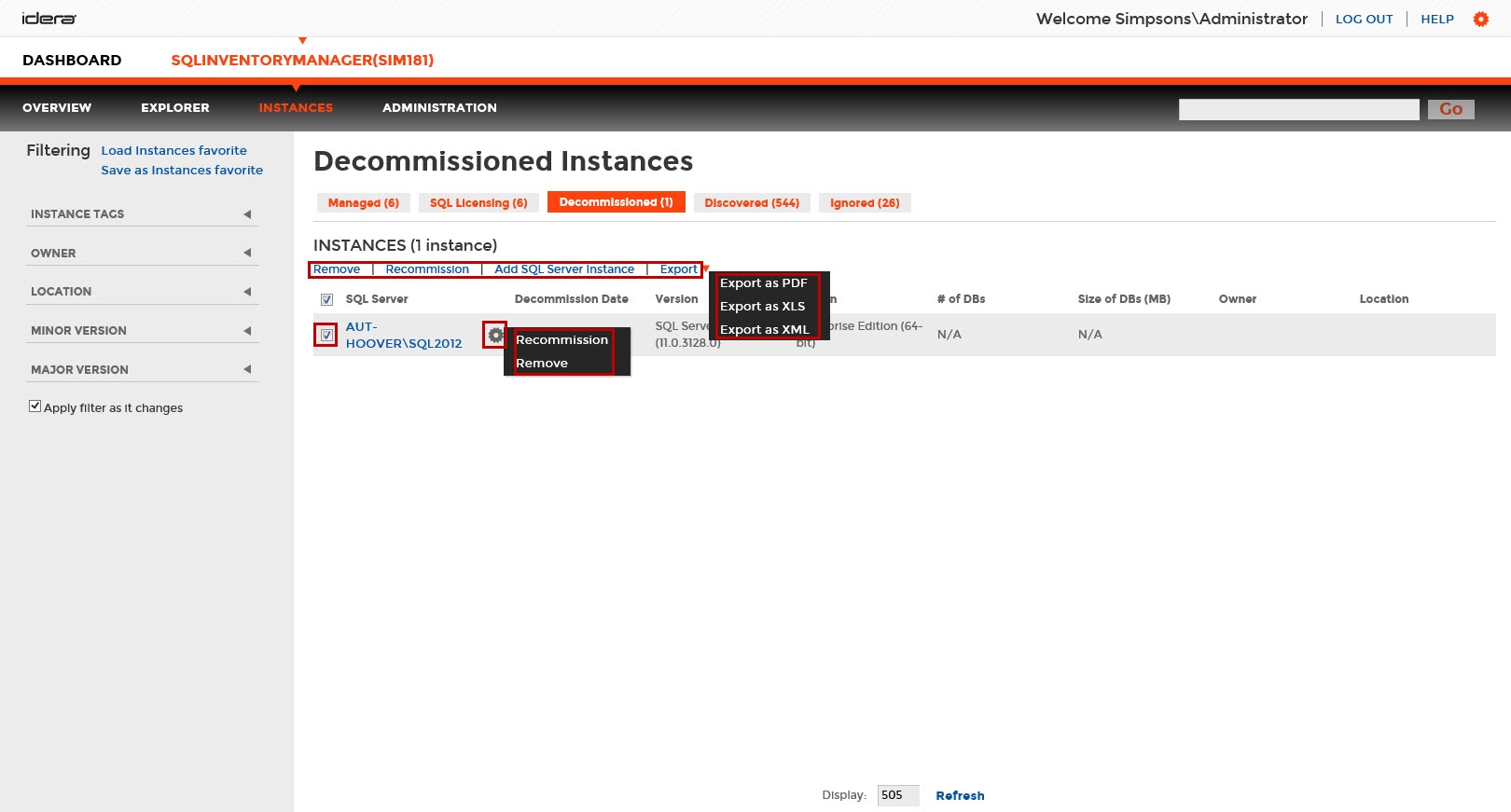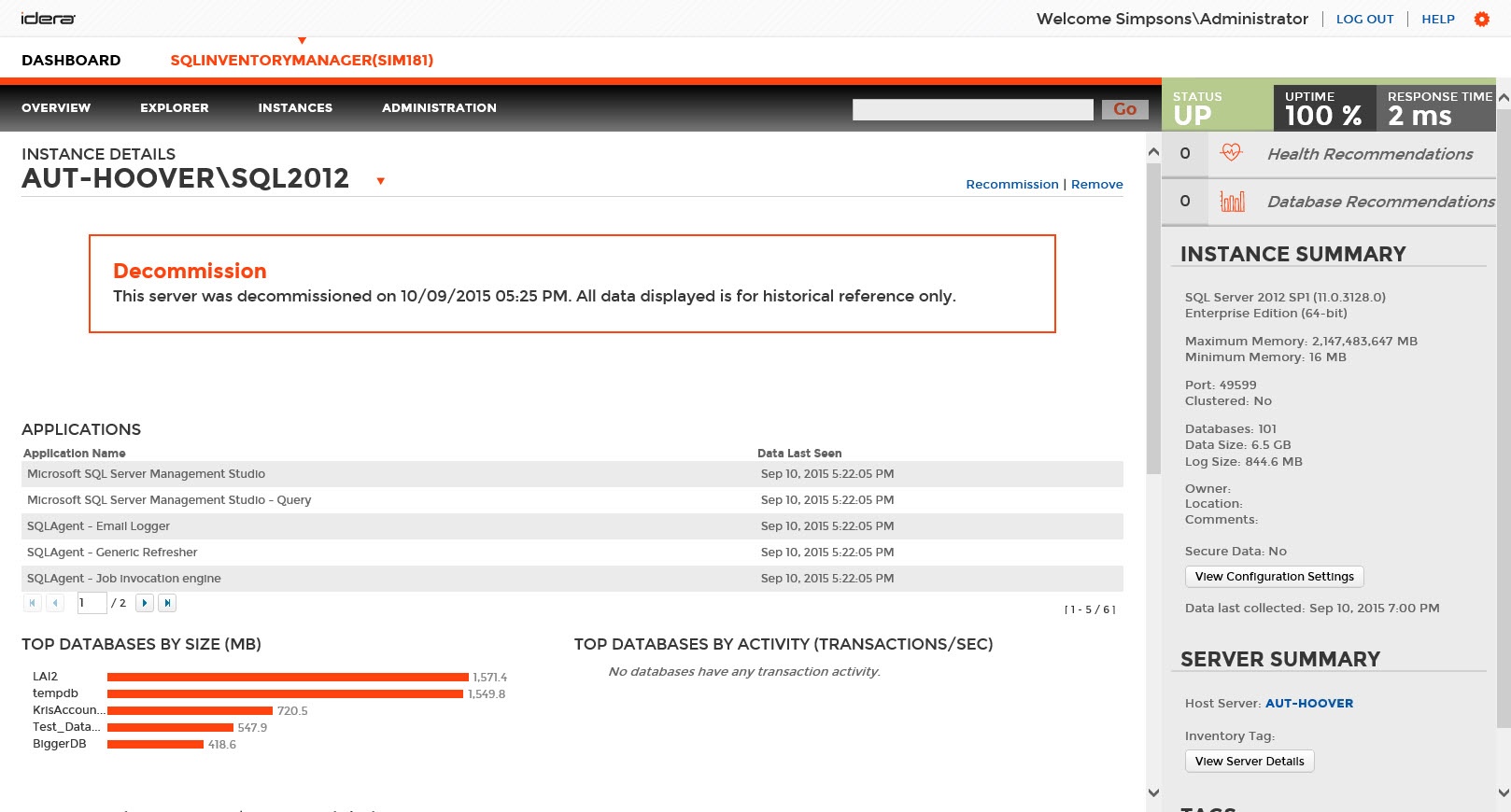IDERA SQL Inventory Manager users can mark instances and databases as "decommissioned" within the product, thereby preventing erroneous alerting yet retaining the data for historical purposes. Decommissioned items are not monitored, do not trigger alerts or recommendations, and do not count against your SQL Inventory Manager license. The data stored before an item is decommissioned remains in the repository database, but is only included in the Decommissioned tab in the Instances view and the Decommissioned Databases list at the bottom of the Instance Details view.
The Decommissioned tab and the Decommissioned Databases list show information about decommissioned items such as the name, timestamp of decommission, SQL Server version and edition (Instance only), recommendations (Databases only), and more. To access the Decommissioned tab, go to the Instances tab, and click Decommissioned.
Available options
On the Decommissioned view there are two options available on the action items bar:
- Add SQL Server instances . Click this option to go to the respective wizard and add new SQL Server instances.
- Export. You can choose any of the following formats: PDF, XLS, or XML for exporting the information displayed on the Decommissioned view.
You can type on the bottom section of this view the number of instances you want SQL Inventory Manager to display per page. Click Refresh to apply the changes.
Options available when you select instances
On the Decommissioned view SQL Inventory Manager allows you to perform several actions on a single instance as well as bulk actions on several selected instances.
If you select one or more instances, you can perform the following actions:
- Recommission
- Remove
You can also access most of these options from the gear icon next to the selected instance. To access the instance details view, you can click directly on the instance name.
Viewing instance details
You can access an instance details view by clicking directly on the instance name. For more information about what information is available on the instance details view, refer to Viewing instance details. Decommissioned instances display a large message including the timestamp when the instance was decommissioned and to remind the user that all displayed data is for historical purposes only.
Remove
If you no longer want to manage an instance, you can remove it by selecting the respective instance, going to More Actions on the action items bar, and selecting Remove. You can also find this option by clicking the gear icon next to the instance. SQL Inventory Manager displays all removed instances on the Ignored instances view. For more information about removing instances click here.
Recommission
Select an instance and click Recommission on the action items bar. You can also find this option by clicking the gear icon next to the respective instance. On the confirmation message dialog, verify the correct instance(s) appears, and then click Yes. Note that the instance disappears from the Decommissioned tab and appears on the Managed tab. Remember that this instance is now active and does count against your SQL Inventory Manager license.
Add SQL Server instance
If you want to access the Add SQL Server instance wizard, click Add SQL Server instance. The wizard opens and allows you to browse and register SQL Server instances.
Exporting from the Decommissioned view
On the action items bar of the Decommissioned view, you can find the Export option which allows you to choose your preferred format for exporting the information available on this view. You can export as a PDF, XLS, or XML file. The filters you choose on this view will be taken into account for your exported reports.
Filtering on the Decommissioned view
On the left section of this view you can find options for filtering your instances by Instance Tags, Owner, Location, Minor Version, and Major Version. Use these filters to quickly access specific instances that you want SQL Inventory Manager to display on this view. For example, you can choose to display the list of decommissioned instances that have a specific tag in your environment.
Creating a useful filter to "weed out" unnecessary information takes time but is important when managing large environments. As a result, you may want to save that filter for future use. SQL Inventory Manager now allows you to save filters for use in the Explorer and Instances views. Simply create the filter, and then click Save as Explorer favorite or click Save as Instances favorite, depending on which view you are in when creating the filter. To use that filter, click Load Explorer favorite or click Load Instances favorite.
You can enable or disable the option Apply filter as it changes depending if you want to see the changes as you apply the filter, or if you prefer to select your filters first and see the results when you finish.
Tip
Need more help? Search the IDERA Customer Support Portal.

